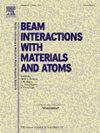高能粒子辐射与氮化硼纳米管相互作用的研究
IF 1.4
3区 物理与天体物理
Q3 INSTRUMENTS & INSTRUMENTATION
Nuclear Instruments & Methods in Physics Research Section B-beam Interactions With Materials and Atoms
Pub Date : 2025-04-28
DOI:10.1016/j.nimb.2025.165719
引用次数: 0
摘要
氮化硼纳米管(BNNT)由于其优异的热学和力学性能而被广泛认为是最有前途的宇宙辐射屏蔽纳米材料之一,而高能粒子(在宇宙环境中从MeV到GeV水平)辐照BNNT的研究尚未开展。在本研究中,进行了100 MeV质子(银河宇宙射线中最常见的粒子)和200 keV氩离子和氮离子对BNNT的辐照实验,并进行了理论评估。采用多种分析手段对辐照前后的BNNT结构进行了表征,得到了离子束辐照后BNNT结构略有紊乱的结果。基于离子在物质中的停止和范围(SRIM)程序估计了造成BNNT结构损伤的原子位移数。此外,利用粒子和重离子输运码系统(PHITS)探讨了高能粒子与BNNT相互作用的详细机制。分析表明,辐照后BNNT的结晶度下降主要是由于高能离子向B和N原子传递动能,导致晶格位移和键断裂。这项研究为在高能离子和质子主导的宇宙辐射环境下BNNT的可行性提供了重要的见解。本文章由计算机程序翻译,如有差异,请以英文原文为准。
Investigation of the interactions of highly energetic particulate radiations with boron nitride nanotubes
Boron nitride nanotubes (BNNT) have been widely recognized as one of the most promising nanomaterials for cosmic radiation shielding due to their exceptional radiation-shielding effectiveness in addition to their excellent thermal and mechanical properties, while the investigations of highly energetic particles (ranging from MeV to GeV levels in the cosmic environment) irradiation on BNNT have not been conducted. In this study, the irradiations of 100 MeV protons (the most popular particles in the galactic cosmic ray) and 200 keV argon and nitrogen ions on BNNT were conducted experimentally, followed by theoretical assessments. Various analytical means were employed to characterize the BNNT structures before and after the irradiation, presenting the slightly disordered structures of BNNT after the ion beam irradiation. The numbers of atom displacements creating the BNNT structural damage were estimated based on the Stopping and Range of Ions in Matter (SRIM) program. In addition, the detailed interaction mechanism of high-energy particles with BNNT was also explored using the Particle and Heavy Ion Transport Code Systems (PHITS). The analyses show that the decrease in the crystallinity of BNNT after the irradiation primarily resulted from kinetic energy transfer from high-energy ions to B and N atoms, leading to lattice displacement and bond breakage. This investigation provides an essential insight into the BNNT feasibility under the cosmic radiation environment dominated by high-energy ions and protons.
求助全文
通过发布文献求助,成功后即可免费获取论文全文。
去求助
来源期刊
CiteScore
2.80
自引率
7.70%
发文量
231
审稿时长
1.9 months
期刊介绍:
Section B of Nuclear Instruments and Methods in Physics Research covers all aspects of the interaction of energetic beams with atoms, molecules and aggregate forms of matter. This includes ion beam analysis and ion beam modification of materials as well as basic data of importance for these studies. Topics of general interest include: atomic collisions in solids, particle channelling, all aspects of collision cascades, the modification of materials by energetic beams, ion implantation, irradiation - induced changes in materials, the physics and chemistry of beam interactions and the analysis of materials by all forms of energetic radiation. Modification by ion, laser and electron beams for the study of electronic materials, metals, ceramics, insulators, polymers and other important and new materials systems are included. Related studies, such as the application of ion beam analysis to biological, archaeological and geological samples as well as applications to solve problems in planetary science are also welcome. Energetic beams of interest include atomic and molecular ions, neutrons, positrons and muons, plasmas directed at surfaces, electron and photon beams, including laser treated surfaces and studies of solids by photon radiation from rotating anodes, synchrotrons, etc. In addition, the interaction between various forms of radiation and radiation-induced deposition processes are relevant.

 求助内容:
求助内容: 应助结果提醒方式:
应助结果提醒方式:


